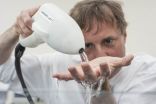How much water do US fracking operations really use?
2015-09-16
(Press-News.org) The oil and gas extraction method called hydraulic fracturing remains controversial for multiple reasons, one of which is its water use. But, as scientists report in ACS' journal Environmental Science & Technology Letters, water requirements for the process are potentially lower than those for some other energy-related extraction methods.
Since oil and gas companies ramped up hydraulic fracturing, or fracking, to unlock oil and gas from shale and tight oil formations, reports of earthquakes and contaminated water near wells proliferated. Some environmental experts have also raised concerns over the huge volumes of water required to make these unconventional wells, especially in drought-stricken places. But assessing this latter concern was difficult since no one had a complete picture of how much water has been used in fracking operations across the country. So Avner Vengosh and Andrew Kondash decided to find out.
The researchers culled data from multiple sources, including government agencies and industry. They estimated that energy companies consumed nearly 250 billion gallons of water between 2005 and 2014 for hydraulic fracturing. This is more water per unit of energy produced than conventional oil and gas exploration requires for drilling and cementing wells. But underground coal and uranium mining, as well as enhanced oil recovery, use about two-and-a-half to 13 times more water per unit of energy produced. Also, they calculated that water for fracking accounts for less than 1 percent of annual total industrial water use in the U.S. Still, the researchers note that in drought-stricken areas such as the Barnett formation in Texas, home to thousands of unconventional wells, local water shortages could limit future use of hydraulic fracturing.
INFORMATION:
The authors acknowledge funding from the National Science Foundation and the Duke University Energy Initiative.
The American Chemical Society is a nonprofit organization chartered by the U.S. Congress. With more than 158,000 members, ACS is the world's largest scientific society and a global leader in providing access to chemistry-related research through its multiple databases, peer-reviewed journals and scientific conferences. Its main offices are in Washington, D.C., and Columbus, Ohio.
To automatically receive news releases from the American Chemical Society, contact newsroom@acs.org.
Follow us: Twitter
Facebook
ELSE PRESS RELEASES FROM THIS DATE:
2015-09-16
Detecting breast cancer in women with dense mammary tissues could become more reliable with a new mammogram procedure that researchers have now tested in pre-clinical studies of mice. In their report in the journal ACS Nano, they describe injecting gold nanoparticles in mammary tissue to enhance the imaging of early signs of breast cancer.
Mammography remains the clinical gold standard of screening tests for detecting breast cancer. However, a recognized limitation of this X-ray procedure is that dense breast tissue shows up as white masses and fibers on an image, ...
2015-09-16
Citizen science is taking off and could make a difference at regional and national regulatory levels. But not everyone thinks that's a good idea. The cover story of Chemical & Engineering News (C&EN), the weekly newsmagazine of the American Chemical Society, delves into the progress of the budding movement, as well as the pushback.
Steven K. Gibb, senior editor at C&EN, reports that in some states, regulators actively encourage and support local residents' participation in environmental monitoring. For example, Maryland's Department of the Environment and Department ...
2015-09-16
Fossils tell amazing stories and inspire them, too -- just think of this summer's "Jurassic World" blockbuster. But because some of the processes that preserve fossils are not well understood, there's still more information that they could reveal. Now scientists report in ACS' journal Analytical Chemistry a new way to probe fossils to find out how these ancient remains formed in greater detail than before.
When most organisms die, they biodegrade and leave little behind. But if they get trapped in sediments that harbor few bacteria and loads of dissolved minerals, they ...
2015-09-16
Coughing. A sore throat. Maybe a pain in your chest as you take a deep breath.
These are all common symptoms for many city-living Australians when smog levels are high. And while it is well understood that smog can cause such problems, new research has for the first time given us a glimpse as to what might be happening at the molecular level.
The University of Melbourne's Professor Richard O'Hair, from the School of Chemistry's Bio21 Institute, in collaboration with Professor Stephen Blanksby (from the Queensland University of Technology and formerly the University ...
2015-09-16
Researchers from the University of Southampton have demonstrated how a pioneering ultrasonic device can significantly improve the cleaning of medical instruments and reduce contamination and risk of infection.
StarStream, invented and patented by the University of Southampton and in commercial production by Ultrawave Ltd., makes water more efficient for cleaning by creating tiny bubbles which automatically scrub surfaces. The device supplies a gentle stream of water through a nozzle that generates ultrasound and bubbles, which dramatically improve the cleaning power of ...
2015-09-16
This news release is available in German.
Platinum is a great catalyst and can be used for many different applications. It's expensive stuff though, so tiny platinum nanoparticles sitting on cheap metal oxide materials are used to convert harmful carbon monoxide into carbon dioxide. Using scanning tunnelling microscopes, scientists at TU Vienna have now been able to image the catalytic behaviour of platinum sitting on iron-oxide, which allowed them to explain the process on an atomic scale. Surprisingly, the chemical reactions do not take place on the platinum ...
2015-09-16
Researchers at the University of Birmingham have shown how the development of coated silica nanoparticles could be used in restorative treatment of sensitive teeth and preventing the onset of tooth decay.
The study, published in the Journal of Dentistry, shows how sub-micron silica particles can be prepared to deliver important compounds into damaged teeth through tubules in the dentine.
The tiny particles can be bound to compounds ranging from calcium tooth building materials to antimicrobials that prevent infection.
Professor Damien Walmsley, from the School of ...
2015-09-16
This news release is available in German.
Topical research experiments are often too expensive or too complex to be rebuilt and incorporated in teaching. How can one, nevertheless, make modern science accessible to the public? This challenge was tackled in the research group Quantum Nanophysics led by Markus Arndt at the University of Vienna. For the first time, two research laboratories were created as complete, photorealistic computer simulations allowing university and high-school students as well as the general public to virtually access unique instruments. ...
2015-09-16
EUGENE, Ore. -- (Sept. 16, 2015) -- New research at the University of Oregon finds that an organization's logo on a food product can trigger quick perceptions by consumers about an item's healthiness and influence their decision-making.
That perception also may be seen as an endorsement that may not exist, say study co-authors Elizabeth Minton of the University of Wyoming and T. Bettina Cornwell, the Edwin E. & June Woldt Cone Professor of Marketing in the Lundquist College of Business at the UO.
The research, led by Minton as part of her doctoral dissertation at the ...
2015-09-16
TORONTO [11 September 2015] A team of astronomers has given us our best view yet of an exoplanet moving in its orbit around a distant star. A series of images captured between November 2013 to April 2015 shows the exoplanet β Pic b as it moves through 1 ½ years of its 22-year orbital period.
First discovered in 2008, β Pic b is a gas giant planet ten to twelve times the mass of Jupiter, with an orbit roughly the diameter of Saturn's. It is part of the dynamic and complex system of the star β Pictoris which lies over 60 light-years from Earth. The ...
LAST 30 PRESS RELEASES:
[Press-News.org] How much water do US fracking operations really use?



